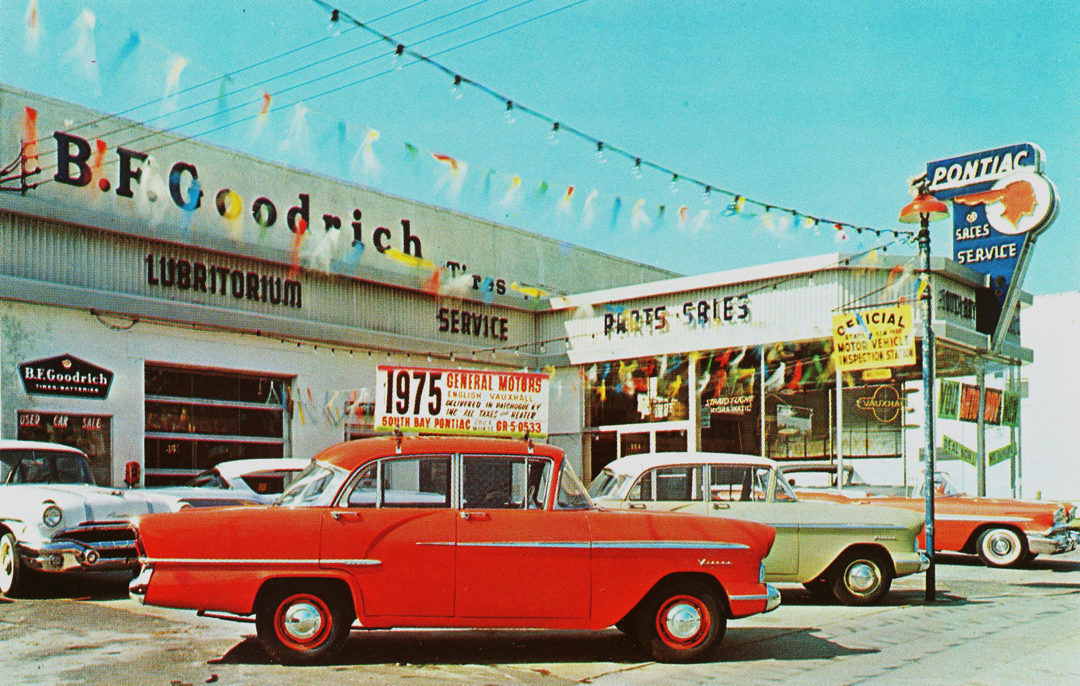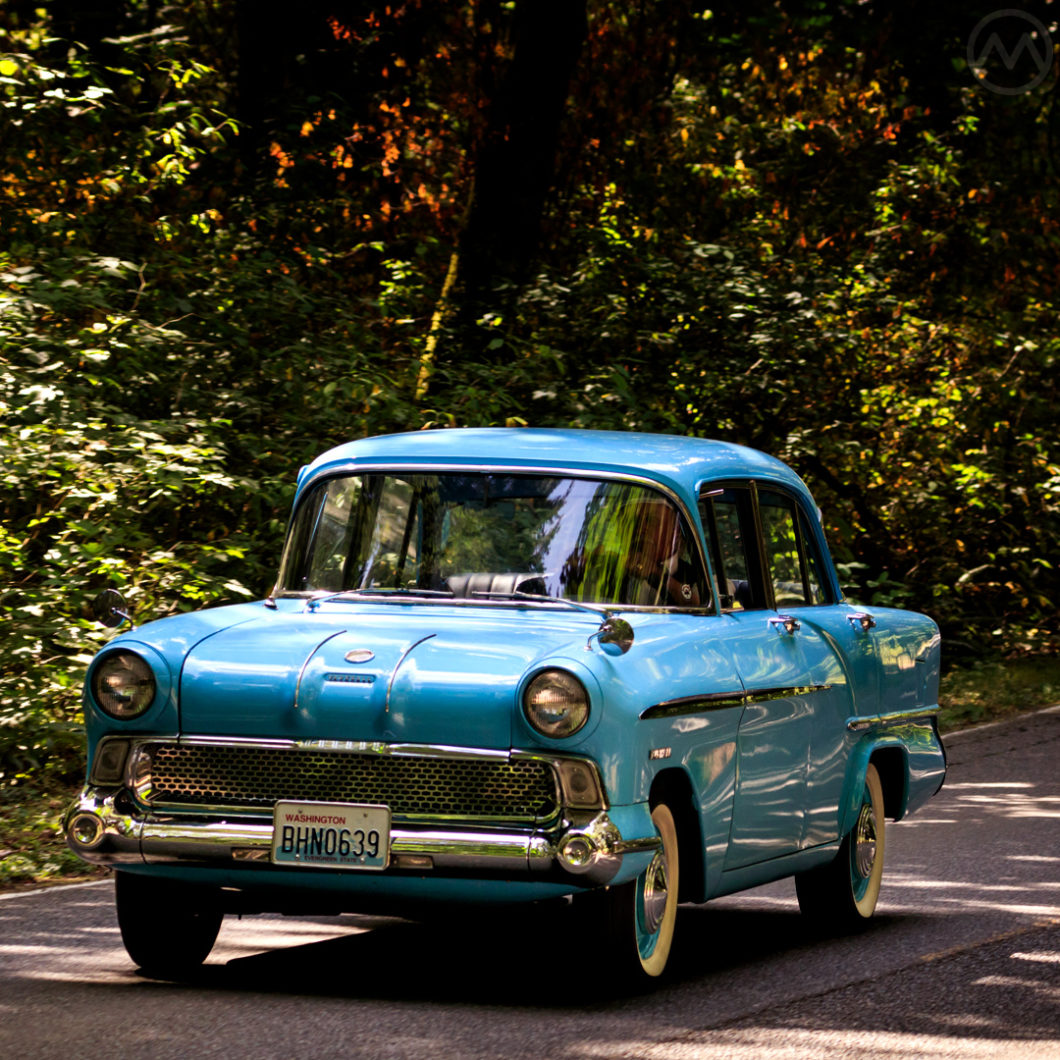You don’t often see Vauxhalls in the USA, but for a little while, one member of GM’s British contingent was as transatlantic as Katherine Hepburn’s accent. What you see here is an F-type Vauxhall Victor, a car familiar to Brits but probably unknown to most U.S. readers.
The Victor was one of a pair of new Motorama-inspired Vauxhalls that brought Detroit style to Vauxhall in 1957, the other being the larger and even-wilder PA Cresta and Velox. Unlike the PA series cars, which were exported to North America only in tiny numbers, the Victor brought a little bit of England back to the USA.
In one of the earliest “captive import” arrangements, Pontiac dealers were stocked with Vauxhalls from 1957 to 1961, a situation that mirrored Buick’s arrangement with Opel. Both setups sprang from the big plans of GM boss Harlow “Red” Curtice, and it was Curtice who approved the Victor’s very American looks – sort of a scaled-down ‘55 Chevy.
For a brief moment, the Victor was Britain’s most widely-exported car and temporarily popular stateside – but it didn’t last. The advent of Detroit’s own compacts crushed mid-market imports like the Victor and the Opel Rekord, and by 1962, Vauxhall was gone from the USA. (But not Canada – more on that later).
Vauxhall and Red Curtice
GM bought Vauxhall in 1925, and American themes ran through its styling from early on in GM’s ownership, but it wasn’t until the early fifties and the E-type Wyvern/Velox that the themes became really overt (I’m sure some Vauxhall fan will disagree), resembling a scaled-down, slightly updated 1951 Chevrolet.
Harlow “Red” Curtice assumed GM’s Presidency in 1953 after a long and steady rise. In 1914, the 20-year-old Curtice answered a want ad for an accountant at GM’s AC Spark Plug division. Within a year he was AC’s comptroller, and he continued to rise on the ladder ever after.
He didn’t start out as a product man, but that didn’t hold him back. Like Lee Iacocca a generation later he very much understood the value of what customers could see and feel in their cars. In the 1930s he’d turned Buick from a flagging has-been into the fourth-best selling nameplate in America and never looked back.
Despite the post-Korean War recession that was happening when he assumed the Presidency (the previous President, Charlie Wilson, left to become Secretary of Defense), he made big bets on expanding production all over GM in 1954, 1955, and 1956. His tour of the global operations took him to Luton in the fall of 1954, where he was presented with two proposals for a new 1.5-liter Vauxhall.
Curtice’s plans for Vauxhall’s future included a £36M investment in Luton’s production and design facilities and an expansion of the Vauxhall line from one basic model to two – the PA would be the larger car, the F-type Victor the smaller one, with only a single 1.5-liter engine and very targeted marketing.
Vauxhall’s design boss was David Jones, a former Harley Earl apprentice during the early “Art and Colour” days and a Vauxhall vet since the early 1930s. Jones led the creation of both of the new Vauxhall models, adapting Pontiac and Cadillac style cues for the PA and Chevrolet ones for the Victor.
In setting up the proposals to show Curtice, he created two alternates – a very American looking flashy one and a rather dowdy looking conservative one. Unsurprisingly, Curtice chose the former on the spot.
The F-type Vauxhall Victor
Getting two completely new models done at the same time proved very taxing on Luton’s relatively small staff (relative to the vast corridors of Detroit, anyway). Curtice and Detroit’s man-in-Europe, overseas operations boss Edward Riley, felt that some of the work on the F-type should be done in the USA at Fisher Body.
The clay model Curtice had approved was (reportedly) damaged in transit, and Fisher’s draftsmen made the final result look even more American than the original intent.

That didn’t matter – American trends were all the rage in the mid-1950s, as were wraparound windshields, featured on all the latest GM cars. The Victor also got exhaust “portholes” in the rear bumper, just like Detroit’s latest dreamboats. Unfortunately that feature contributed to the Victor’s nasty habit of rusting – but that came later.
Inside, it had a standard bench seat and shifter on the column. The wraparound windshield gave it the same look and feel as an American car. It was just like a Chevy inside and out, but smaller.
The Victor’s mechanical pieces were very conventional. Developed under chief engineer Maurice Platt with help from Detroit and Riley’s second-in-command, engineer Peter Hoglund, it was a durable and simple machine. 1.5 liters, three speeds, nothing fancy, but a good family car by European standards.
The Pontiac Connection
With imports surging in the USA in the mid 1950s, Curtice decided that some of GM’s foreign machinery would be right at home in American showrooms, particularly if it looked related to the American cars on the forecourt.
Both Opel and Vauxhall were creating overtly American-style European cars, and both ended up in U.S. showrooms. Opels came first to Buick dealers, and then Pontiac got Vauxhalls starting in September of 1957.
The first F-types were built in February of ‘57, and the plan had always been to export them. Britain was still in export mode – and the timing couldn’t have been better for the Victor.
The sharp Eisenhower Recession of 1957-58 greatly boosted sales of economical imports, and the Opel and the Vauxhall both looked American and came with the backing of GM.
Notably, 1958 was the year Curtice retired, with the project going strong.
The Victor was slow and small by U.S. standards – 30 seconds to 60mph and really more of a four-seater – but it looked right and it was inexpensive. Offered as a sedan and a wagon, it was briefly popular for the first 18 months or so.

Then came Detroit’s own compacts, which absolutely crushed sales of mid-market imports. Jaguar buyers wouldn’t be seen in a Ford Falcon, and it was too big for Volkswagen and Renault buyers – but Opel’s Rekord, Vauxhall’s Victor, and Ford’s Consul were virtually wiped out.
Buick suspended Opel sales around the same time Pontiac gave up on Vauxhall – in late 1961.
By then there was a new Victor – a much more restrained looking car styled by Jones’ team with the help of ex-BMC man Gerald Palmer, whom we’ve talked about before. But there was also Pontiac’s own Tempest – a much bigger and faster car than the Victor and not very much more expensive.
Buick eventually revisited the smaller Opels and found success with them, but Vauxhall never returned to the USA. It did, however, continue in Canada into the early 1970s. In Canada, they were also sold under the “Envoy” label and sometimes seen at Oldsmobile dealers. The the flood of cheaper Detroit-based cars after the 1965 Auto Pact gradually winnowed away Vauxhall’s Canadian beachhead.
At home, the Victor was a big success – nearly 380,000 were made and 100K in the first 15 months alone (including many of those American exports), but rust got the better of many of them in the early 1960s.


I remember these cars from my childhood, when the UK roadworthiness test was only applied to cars after their 10th year.
The prevailing wisdom was that no Vauxhalls ever failed the test, because the rust got them before it was due.
Things didn’t improve much for decades after.
From side on the Victor has more than a passing resemblance to the 1960 FB Holden:
https://www.whichcar.com.au/features/holden-fb-holden-ek-history